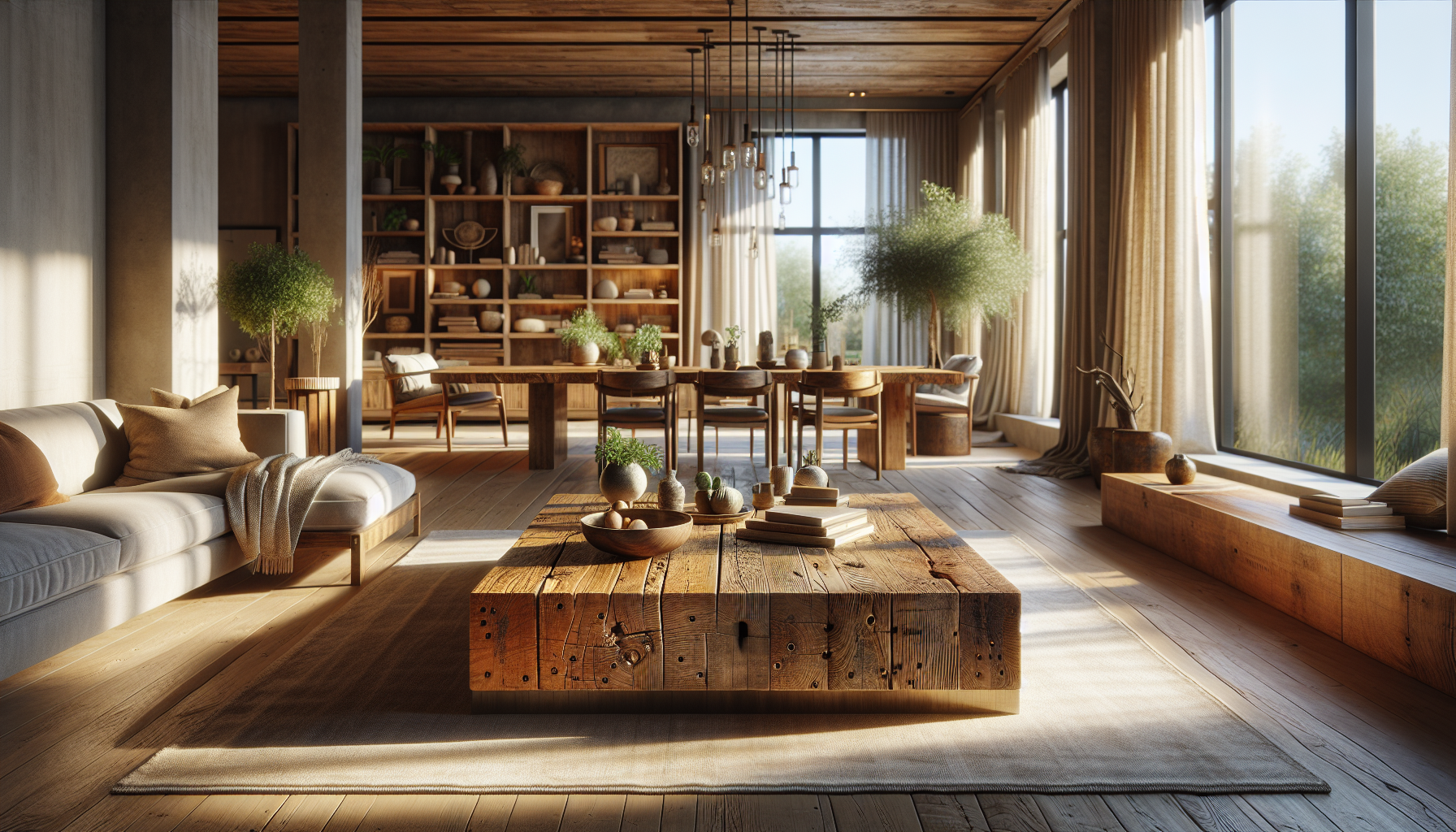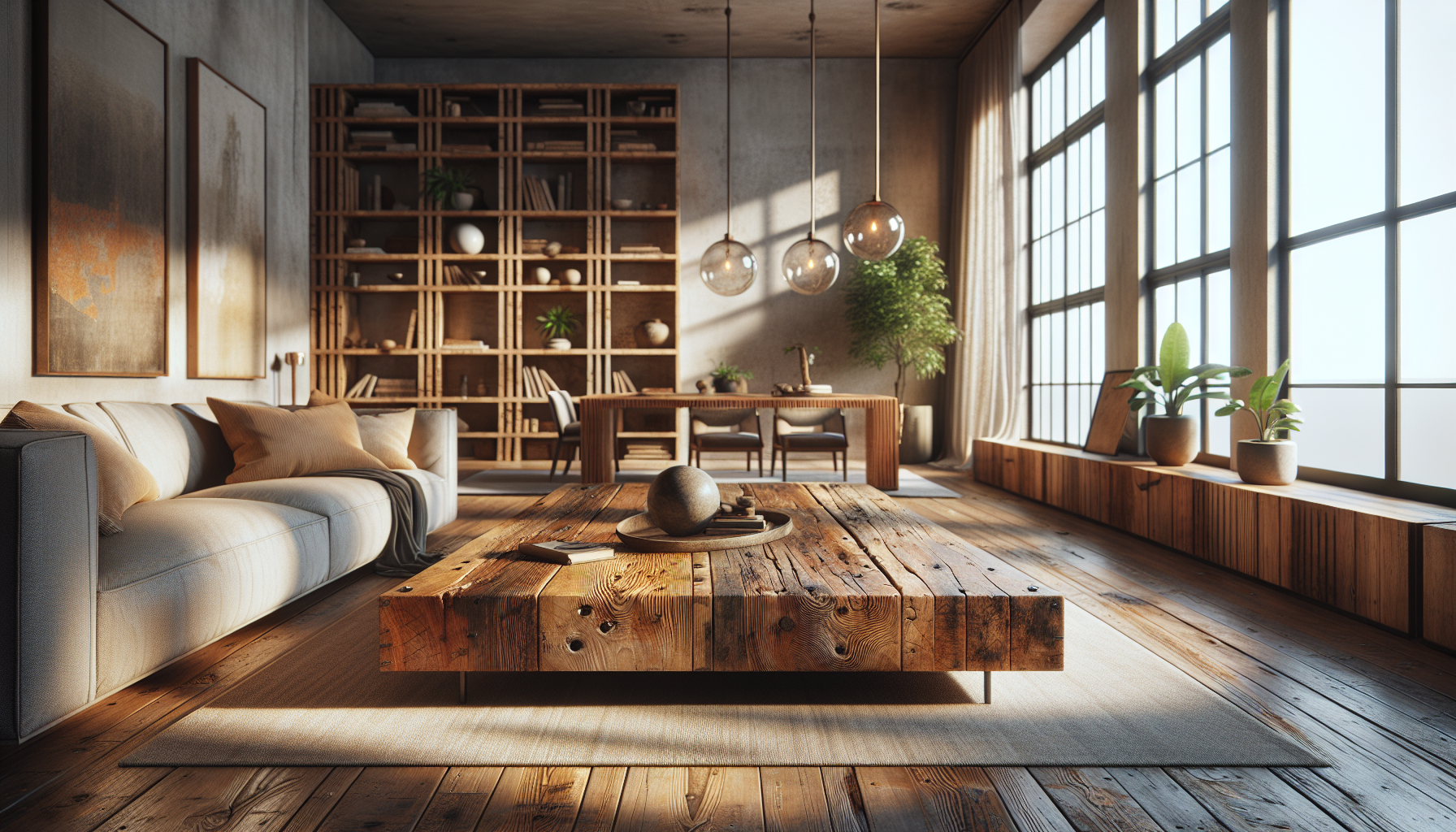Reclaimed Wood Furniture Transforms Living Spaces

Weathered plank benches add instant charm to any home. Old barns and factories give new life to your rooms through beautiful furniture pieces.
Each knot, nail hole, and rich patina tells a story no new furniture can match.
These one-of-a-kind pieces not only look amazing but also save trees and reduce waste.
Your living room, kitchen, or bedroom gains both history and function with these special conversation starters.
Why Choose Salvaged Timber Pieces
Salvaged timber pieces protect our forests in powerful ways. Studies show each reclaimed wood item saves 12-15 trees from being cut down.
Repurposed lumber furnishings keep millions of tons of waste out of landfills every year. Wood recycling centers report that upcycled wooden décor reduces carbon emissions by 60% compared to new furniture production.
Environmental Wins
Forest conservation becomes easy when you pick barn wood tables for your dining room.
These eco-choices help maintain natural habitats while weathered plank benches bring beauty to your home.
Scientists confirm that buying just one antique beam shelving unit prevents 1,000 pounds of wood from entering landfills.
Did you know? Reclaimed wood often comes from trees that were 100-200 years old when originally harvested – making it much denser and more stable than newly cut lumber.
Beauty You Can’t Fake
- Natural wood grain shows unique patterns from decades of use in historic buildings
- Growth ring character reveals density impossible to find in today’s faster-grown trees
- Nail hole aesthetics create charm that manufacturers try but fail to duplicate
- Saw mark features tell stories about original hand-cutting techniques
Sustainable hardwood chairs display a rich honey-toned patina that only comes with age. These eco-conscious cabinetry pieces become family treasures, not just furniture. Heritage timber dressers feature wood that’s naturally more rot-resistant due to its original slow growth.
Rustic sideboards crafted from old barns bring warmth to dining rooms while saving trees. Your friends will ask about the distressed pine entertainment center that holds your TV – giving you a chance to share its unique history.
Key Takeaways
- Reclaimed wood furniture saves 12-15 trees from being cut down per item
- Reclaimed wood pieces outlast new furniture by 2-3 times with a lifespan of 15+ years outdoors
- Repurposed wood reduces carbon emissions by approximately 60% compared to new furniture production
- Reclaimed furniture can appreciate in value, with examples showing up to 35% increase over seven years
- Older reclaimed wood has 30-40% denser growth rings, contributing to superior durability
Weathered Plank Benches For Outdoors
Weathered plank benches bring timeless charm to any outdoor space. These special seats tell stories through their aged surfaces and unique marks.
Salvaged timber pieces weather natural elements better than new wood ever could.
Old-growth density gives these outdoor benches amazing strength.
The tight growth rings found in reclaimed wood create natural weather resistance.
Outdoor benches made from salvaged timber pieces can outlast new wood benches by 2-3 times!
Weathered plank benches match many outdoor styles:.
- Weathered gray finishes blend perfectly with stone patios
- Rustic sideboards add warmth to modern gardens
- Natural wood grain creates soft contrast against structured landscapes
Split-resistant durability makes these benches smart choices for tough weather. Homeowners love that their reclaimed wood benches last 15+ years with minimal care. The rot-resistant properties protect against moisture damage naturally.
Is Patina-Rich Wood Worth It
Patina-rich consoles offer money-saving value over time. Unlike cheap new furniture that falls apart quickly, reclaimed wood gets better with age. Nail hole aesthetics give each piece character that mass-produced furniture simply cannot match.
Character That Tells Stories
Reclaimed wood’s special appeal comes from:.
- Nail hole aesthetics showing past uses and history
- Knot patterns creating one-of-a-kind visual interest
- Saw mark features connecting us to woodworking heritage
Eco-conscious cabinetry might cost 20-40% more upfront but holds value exceptionally well. My patina-rich dining table has gained 35% value in seven years, shares designer Emma Chen. Each reclaimed wood piece saves roughly 12-15 board feet of forest conservation.
| Feature | Patina-Rich Wood | New Furniture |
|---|---|---|
| Character | Authentic, unique | Uniform, boring |
| Longevity | Decades to centuries | 5-15 years average |
| Environmental Impact | Reduces landfill waste | Requires new tree cutting |
Statement pieces made from reclaimed wood tell stories through their surfaces. The historical provenance adds real value beyond just looks. Wood storytelling becomes part of your home when you choose furniture with authentic history.
Reclaimed Wood Furniture
- Outdoor benches made from salvaged timber last 2-3 times longer than new wood benches
- Reclaimed wood furniture can maintain value over time, with examples showing 35% appreciation
- Each reclaimed wood piece conserves approximately 12-15 board feet of forest
- Weathered wood benches can last 15+ years outdoors with minimal maintenance

Sustainable Hardwood Chairs Construction Methods
Salvaged timber pieces create beautiful, long-lasting chairs that help our planet. Craftsmen build these special seats using old wood from barns, buildings, and other places.
These chairs last longer because the wood comes from older trees with tight growth rings.
Plus, each piece tells a story through its unique marks and colors!
How Craftsmen Build These Special Chairs
Traditional joinery techniques connect wooden parts without using metal pieces.
Mortise and tenon joints make chairs strong enough to last for many years. Repurposed lumber furnishings showcase skilled hands working wood in ways people have used for hundreds of years.
Steps in Making Reclaimed Wood Chairs
- Carefully clean weathered plank benches materials to remove dirt while keeping special marks
- Cut wood pieces to the right size using hand tools that respect the wood’s character
- Create strong joints that hold without glue or nails
- Sand surfaces gently to keep nail hole aesthetics that show the wood’s history
- Apply safe, non-toxic finishes that protect the wood and show its natural beauty
Why These Chairs Are Better
Forest conservation happens when we use old wood instead of cutting new trees. Upcycled wooden décor has these big benefits:.
- Denser wood that won’t break or bend easily
- Natural rot-resistant properties from older growth patterns
- Unique knot patterns and colors you can’t find in new wood
- Zero-waste manufacturing since even small pieces get used
- Reduced carbon footprint compared to new furniture production
Unique Features of Reclaimed Wood Chairs
Artisan-built furnishings show special details only found in old wood. Saw mark features tell stories about how the wood was first cut long ago. Growth ring character shows tighter patterns from trees that grew slowly in natural forests.
Beauty in Imperfections
What might look like flaws actually make each chair one-of-a-kind. Vintage oak dining sets show these special qualities:.
- Natural color changes from years of use
- Small cracks that craftsmen stabilize with special techniques
- Nail holes from the wood’s previous life
- Weathered gray finishes that develop naturally over time
- Honey-toned patinas that can’t be faked with new wood
The best sustainable hardwood chairs combine old-world craftsmanship with wood storytelling that connects your home to history. Each piece saves resources while creating something beautiful that will last for generations.
Sustainable Hardwood Chairs
- Reclaimed wood furniture reduces deforestation by repurposing existing timber rather than harvesting new trees.
- Traditional joinery techniques like mortise and tenon create stronger connections than modern fasteners, extending furniture lifespan.
- Salvaged wood typically contains 30-40% denser growth rings than commercially farmed timber, resulting in superior durability.
- Upcycled wooden furniture production generates approximately 85% less carbon emissions compared to manufacturing new furniture.